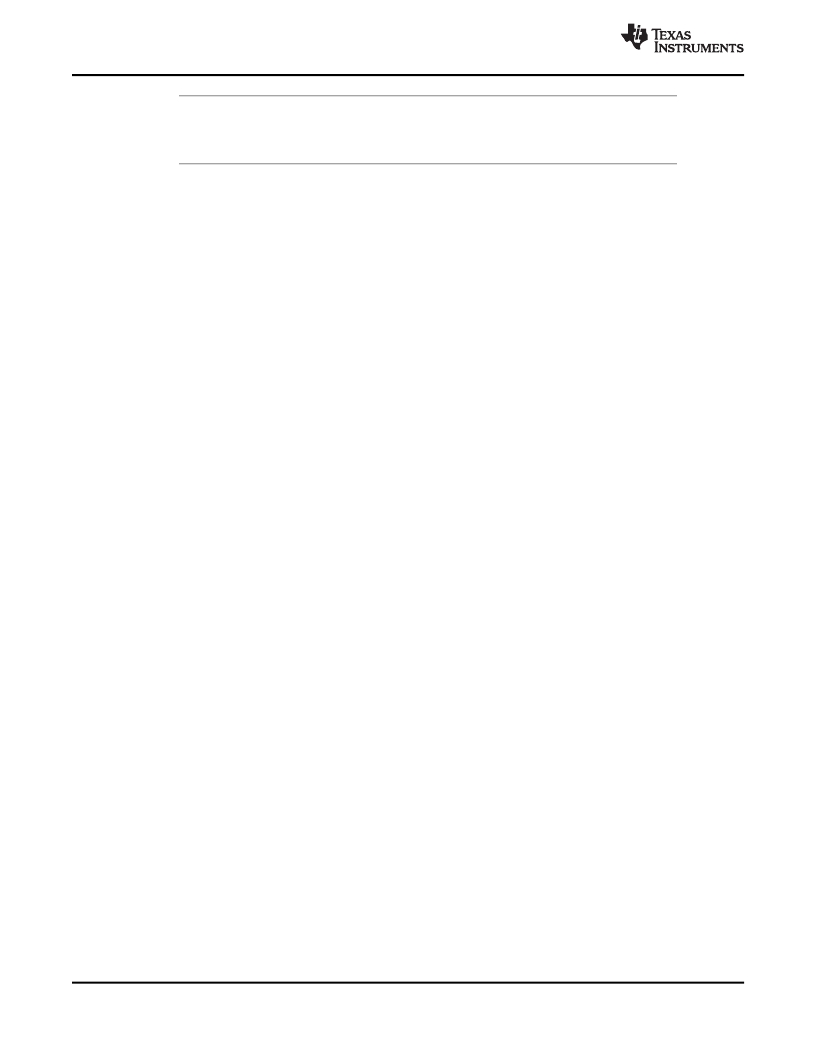- 您现在的位置:买卖IC网 > Sheet目录528 > TRF7970AEVM (Texas Instruments)EVAL MODULE FOR TRF7970A
�� �
�
 �
�TRF7970A�
�SLOS743K� –� AUGUST� 2011� –� REVISED� APRIL� 2014�
�www.ti.com�
�NOTE�
�If� register� setting� changes� are� needed� for� fine� tuning� the� system,� they� must� be� done� after�
�setting� the� ISO� Control� register� (0x01).�
�The� framing� section� also� supports� the� bit-collision� detection� as� specified� in� ISO14443A.� When� a� bit�
�collision� is� detected,� an� interrupt� request� is� sent� and� a� flag� is� set� in� the� IRQ� and� Status� register� (0x0C).�
�The� position� of� the� bit� collision� is� written� in� two� registers:� Collision� Position� register� (0x0E)� and� partly� in�
�Collision� Position� and� Interrupt� Mask� register� (0x0D)� (bits� B6� and� B7).�
�The� collision� position� is� presented� as� sequential� bit� number,� where� the� count� starts� immediately� after� the�
�start� bit.� This� means� a� collision� in� the� first� bit� of� a� UID� would� give� the� value� 00� 0001� 0000� in� these�
�registers� when� their� contents� are� combined� after� being� read.� (the� count� starts� with� 0� and� the� first� 16� bits�
�are� the� command� code� and� the� Number� of� Valid� Bits� (NVB)� byte).�
�The� receive� section� also� contains� two� timers.� The� RX� wait� time� timer� is� controlled� by� the� value� in� the� RX�
�Wait� Time� register� (0x08).� This� timer� defines� the� time� interval� after� the� end� of� the� transmit� operation� in�
�which� the� receive� decoders� are� not� active� (held� in� reset� state).� This� prevents� false� detections� resulting�
�from� transients� following� the� transmit� operation.� The� value� of� the� RX� Wait� Time� register� (0x08)� defines� the�
�time� in� increments� of� 9.44� μs.� This� register� is� preset� at� every� write� to� ISO� Control� register� (0x01)�
�according� to� the� minimum� tag� response� time� defined� by� each� standard.�
�The� RX� no� response� timer� is� controlled� by� the� RX� No� Response� Wait� Time� register� (0x07).� This� timer�
�measures� the� time� from� the� start� of� slot� in� the� anticollision� sequence� until� the� start� of� tag� response.� If� there�
�is� no� tag� response� in� the� defined� time,� an� interrupt� request� is� sent� and� a� flag� is� set� in� the� IRQ� Status�
�register� (0x0C).� This� enables� the� external� controller� to� be� relieved� of� the� task� of� detecting� empty� slots.� The�
�wait� time� is� stored� in� the� register� in� increments� of� 37.76� μs.� This� register� is� also� preset,� automatically� for�
�every� new� protocol� selection.�
�The� digitized� output� of� the� analog� receiver� is� at� the� input� of� the� digital� portion� of� the� receiver.� This� input�
�signal� is� the� subcarrier� coded� signal,� which� is� a� digital� representation� of� modulation� signal� on� the� RF�
�envelope.�
�The� digital� part� of� the� receiver� consists� of� two� sections� which� partly� overlap.� The� first� section� contains� the�
�bit� decoders� for� the� various� protocols.� The� bit� decoders� convert� the� subcarrier� coded� signal� to� a� bit� stream�
�and� also� the� data� clock.� Thus� the� subcarrier� coded� signal� is� transformed� to� serial� data� and� the� data� clock�
�is� extracted.� The� decoder� logic� is� designed� for� maximum� error� tolerance.� This� enables� the� decoders� to�
�successfully� decode� even� partly� corrupted� (due� to� noise� or� interference)� subcarrier� signals.�
�The� second� section� contains� the� framing� logic� for� the� protocols� supported� by� the� bit� decoder� section.� In�
�the� framing� section,� the� serial� bit� stream� data� is� formatted� in� bytes.� In� this� process,� special� signals� like� the�
�SOF� (start� of� frame),� EOF� (end� of� frame),� start� of� communication,� end� of� communication� are� automatically�
�removed.� The� parity� bits� and� CRC� bytes� are� checked� and� also� removed.� The� end� result� is� "clean� or� raw"�
�data� which� is� sent� to� the�
�127-byte� FIFO� register� where� it� can� be� read� out� by� the� external� microcontroller� system.�
�The� start� of� the� receive� operation� (successfully� received� SOF)� sets� the� flags� in� the� IRQ� and� Status�
�register.� The� end� of� the� receive� operation� is� signaled� to� the� external� system� (MCU)� by� sending� an� interrupt�
�request� (pin� 13� IRQ).� If� the� receive� data� packet� is� longer� than� 96� bytes,� an� interrupt� is� sent� to� the� MCU�
�when� the� received� data� occupies� 75%� of� the� FIFO� capacity� to� signal� that� the� data� should� be� removed�
�from� the� FIFO.�
�Any� error� in� data� format,� parity� or� CRC� is� detected� and� the� external� system� is� made� aware� of� the� error� by�
�an� interrupt� request� pulse.� The� nature� of� the� interrupt� request� pulse� is� available� in� the� IRQ� and� Status�
�register� (address� 0x0C).� The� bit� coding� description� of� this� register� is� shown� in� Section� 6.14.3.3.1� .� The�
�information� in� IRQ� and� Status� register� differs� if� the� chip� is� configured� as� RFID� reader� or� as� NFC� device�
�(including� tag� emulation).� The� case� of� NFC� operation� is� presented� in� Section� 6.12� .�
�22�
�Detailed� Description�
�Submit� Documentation� Feedback�
�Product� Folder� Links:� TRF7970A�
�Copyright� ?� 2011–2014,� Texas� Instruments� Incorporated�
�发布紧急采购,3分钟左右您将得到回复。
相关PDF资料
TRM-418-LT
TRANSCEIVER RF 418MHZ LT SERIES
TRM-900-NT
RF TXRX 915MHZ NT SERIES
TRX08GVP2540
TXRX OPT SCFF 8.5GB/S 850NM
TS-320240BRNO
TCH PANEL 140X104 RESISTIVE MONO
TS-TFT3.5Z
TOUCH PANEL 140X1.4.0 TFT
TS3-75B3
SENSOR THERMAL MOXIE NTC 75C
TSL26711FN
IC PROXIMITY DETECTOR 6-DFN
TSOP57238TT1
IC IR RCVR MODULE 38KHZ
相关代理商/技术参数
TRF7970ARHBR
功能描述:IC RFID/NFC AFE 13.56MHZ 32QFN RoHS:是 类别:RF/IF 和 RFID >> RFID IC 系列:- 其它有关文件:CR14 View All Specifications 标准包装:1 系列:- RF 型:收发器 频率:13.56MHz 特点:ISO14443-B 封装/外壳:16-SOIC(0.154",3.90mm 宽) 供应商设备封装:16-SO 包装:Digi-Reel® 其它名称:497-5719-6
TRF7970ARHBT
功能描述:IC RFID/NFC AFE 13.56MHZ 32QFN RoHS:是 类别:RF/IF 和 RFID >> RFID IC 系列:- 其它有关文件:CR14 View All Specifications 标准包装:1 系列:- RF 型:收发器 频率:13.56MHz 特点:ISO14443-B 封装/外壳:16-SOIC(0.154",3.90mm 宽) 供应商设备封装:16-SO 包装:Digi-Reel® 其它名称:497-5719-6
TRF7970ATB
功能描述:RFID应答器 TRF7970A Target Brd RoHS:否 制造商:Murata 存储容量:512 bit 工作温度范围:- 40 C to + 85 C 安装风格:SMD/SMT 封装 / 箱体: 封装:Reel
TRF79A6AA17LB000
制造商:Opnext 功能描述:XFP FORM FACTOR - Boxed Product (Development Kits)
TRF79A6AA18LB000
制造商:Opnext 功能描述:XFP FORM FACTOR - Boxed Product (Development Kits)
TRF79A6AA19LB000
制造商:Opnext 功能描述:XFP FORM FACTOR - Boxed Product (Development Kits)
TRF79A6AA20LB000
制造商:Opnext 功能描述:XFP FORM FACTOR - Boxed Product (Development Kits)
TRF79A6AA21LB000
制造商:Opnext 功能描述:XFP FORM FACTOR - Boxed Product (Development Kits)